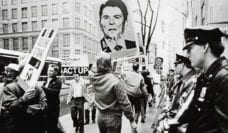In July, 15,000 people living with HIV, activists, researchers, policymakers, and donors gathered in Amsterdam for the 22nd International AIDS Conference. This year’s theme—Breaking Barriers, Building Bridges—focused the world’s attention on sex workers and other marginalized populations disproportionately affected by HIV.
Amsterdam was deliberately chosen to host the 2018 conference because of its high-profile red-light district and the legal status of sex work in the Netherlands. Sex workers were front-and-center in press conferences, panel discussions, and awards ceremonies. They even raucously interrupted President Clinton’s key note address to protest US policies and demand that the 2020 AIDS meeting not be held, as planned, in San Francisco. The US government, they argued, has a long history of violating the human rights of people who sell sex, implementing oppressive laws, and making it difficult for sex workers to protect themselves from HIV and violence.
The Prohibition on the Promotion and Advocacy of the Legalization or Practice of Prostitution or Sex Trafficking embedded in the President’s Emergency Plan for AIDS Relief (PEPFAR) is a particularly egregious example. The Anti-Prostitution Pledge requires organizations receiving US funding to certify that they will not “promote or advocate the legalization or practice of prostitution or sex trafficking.” They must have an explicit policy against sex work and trafficking and agree to not use private funds to support sex workers. It has been derided by many, but its restrictions have gradually loosened over the years. Simultaneously, PEPFAR has committed to promoting the health and wellbeing of sex workers through its focus on key populations. Here’s a brief overview of the current situation and how we arrived here.
Since 2003, PEPFAR has invested $70 billion dollars and has changed the course of the HIV pandemic. It is an enduring positive legacy of George W. Bush’s presidency.
Since 2003, PEPFAR has invested $70 billion dollars and has changed the course of the HIV pandemic. It is an enduring positive legacy of George W. Bush’s presidency. At the same time, Bush’s conservative values also limited PEPFAR programming for many years by pushing abstinence over condoms as a primary form of prevention, and prohibiting needle exchange. Eradicating prostitution is a core goal of the PEPFAR legislation. Forcing countries and public health organizations to comply with the anti-prostitution pledge was one means to that end.
The grip of the Anti-Prostitution Pledge has been the most enduring, but it too has gradually loosened. In 2013 the Supreme Court ruled the Pledge violates freedom of speech. A later win in New York went further, ruling that US organizations and their foreign implementers are protected by the First Amendment. Despite these successful challenges, all organizations receiving PEPFAR funding are still required to certify compliance. And foreign organizations receiving funding directly from the US government are bound by its restrictions.
If you are confused, it’s with good reason. In a direct contradiction of the Anti-Prostitution Pledge, PEPFAR is channeling millions of dollars to programs that support sex workers. Simply type “PEPFAR key populations” into your search engine to find information about the many programs for sex workers the US government supports. PEPFAR’s declaration that it “stands firmly and unequivocally with and for key populations” is based on a detailed ethical framework “ensuring human rights and leaving no one behind.”
I’m not complaining. I have worked with PEPFAR-supported programs focused on the health and human rights of people who sell sex in Ghana and elsewhere. These collaborations have sometimes allowed me to forget that the Anti-Prostitution Pledge is also part of the PEPFAR ethos. I led a PEPFAR-funded study that had an express goal of helping USAID and Ghana’s government better understand the vulnerabilities and needs of adolescents and adults engaging in sex work. The Anti-Prostitution Pledge rarely came up. But we cannot dismiss the Pledge as an unimportant policy relic.
For now, evidence seems to be winning the tug of war with ideology. But we can’t afford to be complacent.
Feature image: Michael Coghlan, Where the ‘Ladies’ Sit (detail), used under CC BY-SA 2.0














